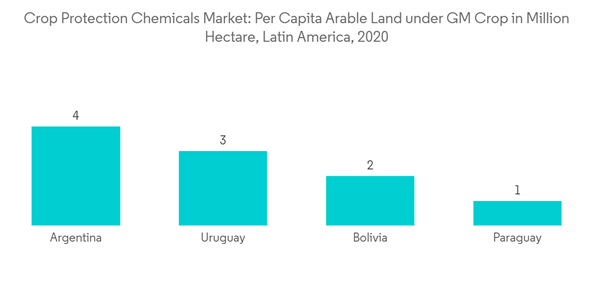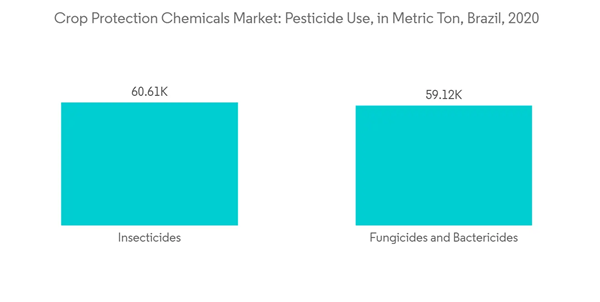The Latin American crop protection chemicals market is poised to register a CAGR of 6.1% during the forecast period.
Brazil and Argentina are both among the top five GM-cultivating countries. Latin America, along with Bolivia, Chile, Colombia, Costa Rica, Honduras, Paraguay, and Uruguay, cultivated 42.7% of the global GM crop area. On the other hand, Brazil and Argentina have chosen an opposite strategy, enabling, purposefully, and fiercely embracing biotech innovation and transforming South America into a global leader in GM crop production. With the adoption of GM crops in these countries, cultivation is anticipated to increase, which is anticipated to have a positive impact on the crop protection chemicals market in the region.
The benefits of transgenic crops include saving water and reducing emissions of carbon dioxide, which help preserve many trees. These crops contain disease-resistant, herbicide-resistance, and drought-resistant genes. Brazil has the largest area under the cultivation of GM crops.
Glyphosate is the best-selling crop protection product in Brazil. It is used mainly on crops like soy, corn, wheat, cotton, and coffee. The herbicide tops the list of the most commercialized agrochemicals in the country, according to a survey by the G1 agency released by the Brazilian Association of Post-Patent Defensives (AENDA). The herbicide 2,4-D is also the second-best-selling crop protection product in Brazil. Its mode of action is different from glyphosate, controlling only one group of weeds. It is one of the bestsellers as it helps manage the resistance that many weeds have developed against glyphosate.
The fungicide, mancozeb, is the third most sold in Brazil and also the oldest. It is again being widely used for controlling a major soy disease, Asian rust, normally mixed with more modern products to ensure the effectiveness of newer products that were losing their effectiveness against the disease. Chinese and Indian companies have been entering Brazil through distribution systems and/or as registration holders, moves that are considered much more lucrative than just supplying products to local distributors.
This product will be delivered within 2 business days.
Key Highlights
- Latin America has the potential to be the global breadbasket of the world because of its rising use of innovation and investment in sustainable agriculture. Finding sustainable ways to feed the rapidly increasing population while satisfying the evolving and diverse dietary needs of the growing global middle class is an opportunity that can be utilized by Latin America. Therefore, the provision of crop protection chemicals plays an important role.
- The Latin American region is a significant exporter of a variety of crops, of which the most significant include soybeans, maize, cotton, sugar, orange juice, coffee, bananas, ornamentals, cocoa, grapes, apples, and other fruits. Pesticides are essential components for the production of these crops and for maintaining export levels. In certain cases, pesticides also supplement ecologically sound practices, such as no-till, which helps preserve soil fertility in the region.
- Globally, the Latin American market is the second-fastest-growing market for crop protection chemicals, and it accounts for more than 23% of the global market share. Joint ventures and new product launches are the major strategies followed by Latin American companies. The pesticide market in Latin America is consolidated, with the top few companies holding the major share, whereas the biopesticide market is fragmented.
Latin America Crop Protection Chemicals Market Trends
Adoption of Genetically Modified (GM) Crops
The use of genetically modified (GM) organisms is the new trend in the market. Due to decreasing arable land in the Latin American region, GM crops are highly preferred to maintain productivity levels. GM crops require a significant amount of crop protection chemicals, which play a vital role in proper growth and good-quality harvests.Brazil and Argentina are both among the top five GM-cultivating countries. Latin America, along with Bolivia, Chile, Colombia, Costa Rica, Honduras, Paraguay, and Uruguay, cultivated 42.7% of the global GM crop area. On the other hand, Brazil and Argentina have chosen an opposite strategy, enabling, purposefully, and fiercely embracing biotech innovation and transforming South America into a global leader in GM crop production. With the adoption of GM crops in these countries, cultivation is anticipated to increase, which is anticipated to have a positive impact on the crop protection chemicals market in the region.
The benefits of transgenic crops include saving water and reducing emissions of carbon dioxide, which help preserve many trees. These crops contain disease-resistant, herbicide-resistance, and drought-resistant genes. Brazil has the largest area under the cultivation of GM crops.
Brazil Dominates the South American Market
Brazil has the largest and one of the fastest-growing markets for crop protection chemicals in South American countries. Brazil has developed from a net food importer to a major exporter, mostly by improving productivity through technology adoption and the use of crop protection chemicalso a major exporter, mostly by improving productivity through technology adoption and the use of crop protection chemicals. Although production has been witnessing a smaller decline, it is expected to rebound with more use of crop protection chemicals.Glyphosate is the best-selling crop protection product in Brazil. It is used mainly on crops like soy, corn, wheat, cotton, and coffee. The herbicide tops the list of the most commercialized agrochemicals in the country, according to a survey by the G1 agency released by the Brazilian Association of Post-Patent Defensives (AENDA). The herbicide 2,4-D is also the second-best-selling crop protection product in Brazil. Its mode of action is different from glyphosate, controlling only one group of weeds. It is one of the bestsellers as it helps manage the resistance that many weeds have developed against glyphosate.
The fungicide, mancozeb, is the third most sold in Brazil and also the oldest. It is again being widely used for controlling a major soy disease, Asian rust, normally mixed with more modern products to ensure the effectiveness of newer products that were losing their effectiveness against the disease. Chinese and Indian companies have been entering Brazil through distribution systems and/or as registration holders, moves that are considered much more lucrative than just supplying products to local distributors.
Latin America Crop Protection Chemicals Market Competitor Analysis
The Latin American crop protection chemicals market is highly consolidated, with the top few companies holding a large share of the market while the rest is held by other multinational and local companies. BASF SE, DowDuPont, Bayer, FMC Corporation, and Syngenta AG are some of the key players with high market shares. New product launches, mergers and acquisitions, and partnerships are the major strategies adopted by the leading companies in the market. These companies also focus on making investments, mainly in new product development, to increase their market share.Additional benefits of purchasing the report:
- The market estimate (ME) sheet in Excel format
- 3 months of analyst support
This product will be delivered within 2 business days.
Table of Contents
1 INTRODUCTION
4 MARKET DYNAMICS
5 MARKET SEGMENTATION
6 COMPETITIVE LANDSCAPE
Companies Mentioned (Partial List)
A selection of companies mentioned in this report includes, but is not limited to:
- Adama Agricultural Solutions Ltd
- BASF SE
- Bayer CropScience AG
- Isagro SpA
- FMC Corporation
- Marrone Bio Innovations Inc.
- Syngenta AG
- Sumitomo Chemical Co. Ltd
- Nutrien Ltd
- Corteva Agrisciences
Methodology

LOADING...










